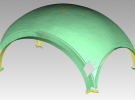GreenSpider test drive on existing buildings
Little tutorial on vaults modeled in Revit
 In my research, I'm deeply concerned about representing existing buildings in BIM domain. Thence, historical buildings are considerably a further reason for my interest. GreeenSpider was originally imagined as a piece of code able to traslate points as reference in Revit, with particular interest in Rhino+Grasshopper's parametric morphologies. However, dealing with real buildings, translating decimated point clouds from laser scanning or digital photogrammetry appeared to be feasible as well.
In my research, I'm deeply concerned about representing existing buildings in BIM domain. Thence, historical buildings are considerably a further reason for my interest. GreeenSpider was originally imagined as a piece of code able to traslate points as reference in Revit, with particular interest in Rhino+Grasshopper's parametric morphologies. However, dealing with real buildings, translating decimated point clouds from laser scanning or digital photogrammetry appeared to be feasible as well.
This post is intended as a practical example of GreenSpider implementation in real world documentation: in this case I would introduce a working pipeline on vault modeling in Revit from an accurate TLS survey.
The quality of data in a laser scanning survey is unequivocally important; starting our work with GreenSpider from a clean and consistent point cloud is, this way, unavoidable.
Using a Faro Cam2 Focus 3D laser scanner (phase shift technology) a vault pertaining to an historical building was captured (see the first picture in this post). This file is often rich of information and every point can be transslated by GreenSpider in a Revit's reference point. However, too many points make a Revit file pretty unmanageable.
Due to this occurrence, point clouds have to be roughly simplified with a rude decimation algorhitm (see first two pictures in the gallery): consider resulting points as a guide for splines tracing in Revit mass modeling environment, they have to be adaptive, correct but not overdetailed, 15 to 30 points per curve are enough.
Hint: cross section made of points can be generated by plenty of programs, even by Meshlab.
Every section has to be saved in a single .XYZ file, so we have here 13 different files since I decided to generate 13 slices from the main point cloud.
Hint: Slices are better when they are thin, the ideal one is a succession of points imagined as laying on a plane or resulting from a single row scan.
In picture three of the gallery below, GreenSpider is invoked from Revit GUI, to translate along the Y axis .XYZ slices one by one. GreenSpider is a prototype so it's still not so robust. This means .XYZ in input and resulting .GSP in output have to be carefully checked to work properly. Files with .XYZ extension have to collect coordinates in text format separed by a space, with NO NORMALS (only coords) and no End-of-File character at the end of the list. an example of .XYZ files used in this tutorial.
Hint: Sometimes GreenSpider Translator could crash with an exception signal. In this case some points.tmp or points.gsp files could be written in C:/greeenspider. Try to remove them with the reset button or delete them by hand, in order to restore normal operational conditions.
In Autodesk Revit, open the mass modeling environment and import translated .GSP files one by one; you can find files used in this tutorial, to check your work. Generating a surface from splines is very easy and resulting vault can be saved as a template family.
This is the end of the workflow: your vault can be imported in a Revit project as generic family, the exported in IFC format and reimported as a ceiling, a roof, a wall and so on.
Nessun commento
Info
Dal 2004 questo piccolo angolo di rete raccoglie gli interessi di ricerca e i lavori di sperimentazione digitale di Simone Garagnani in materia di cultura geek, ma soprattutto di Building Information Modeling, rilievi digitali ad alta risoluzione e computer graphics legata al mondo dell'architettura, dell'ingegneria e delle costruzioni. TC Project, è presente anche sul social network Facebook.
Welcome to these pages that host since 2004 Simone Garagnani's personal blog, a collection of nerd notes and geek experiences focused sometimes on Building Information Modeling, terrestrial laser scanning, digital photogrammetry and computer graphics applied to the AEC world. The TC Project is also available on Facebook.
Segui le attività in TC Project: Registrazione
Follow TC Project activities: Registration/login
Ultimi commenti
Trevor Dwyer (VIC-20 The friend…): Hi there, I feel your pain on updates and the internet not being the same these days – well since 199…SiliconSimon (Cray-1 - The home…): If someone is interested in my little Cray’s files, please PM me since I do not often read comments o…
SiliconSimon (Cray-1 - The home…): Of course Mike, I sent you a PM!
Robert (Cray-1 - The home…): If it’s possible, I would love to get the files from you for this project. I have a Cray-1 chip sitti…
Mike (Cray-1 - The home…): Are the files still available?
MojaMonkey (SGI VW540 @ TC La…): Hi Simon? This is a long shot but I was wondering if you have a copy of the SGI drivers required to…











